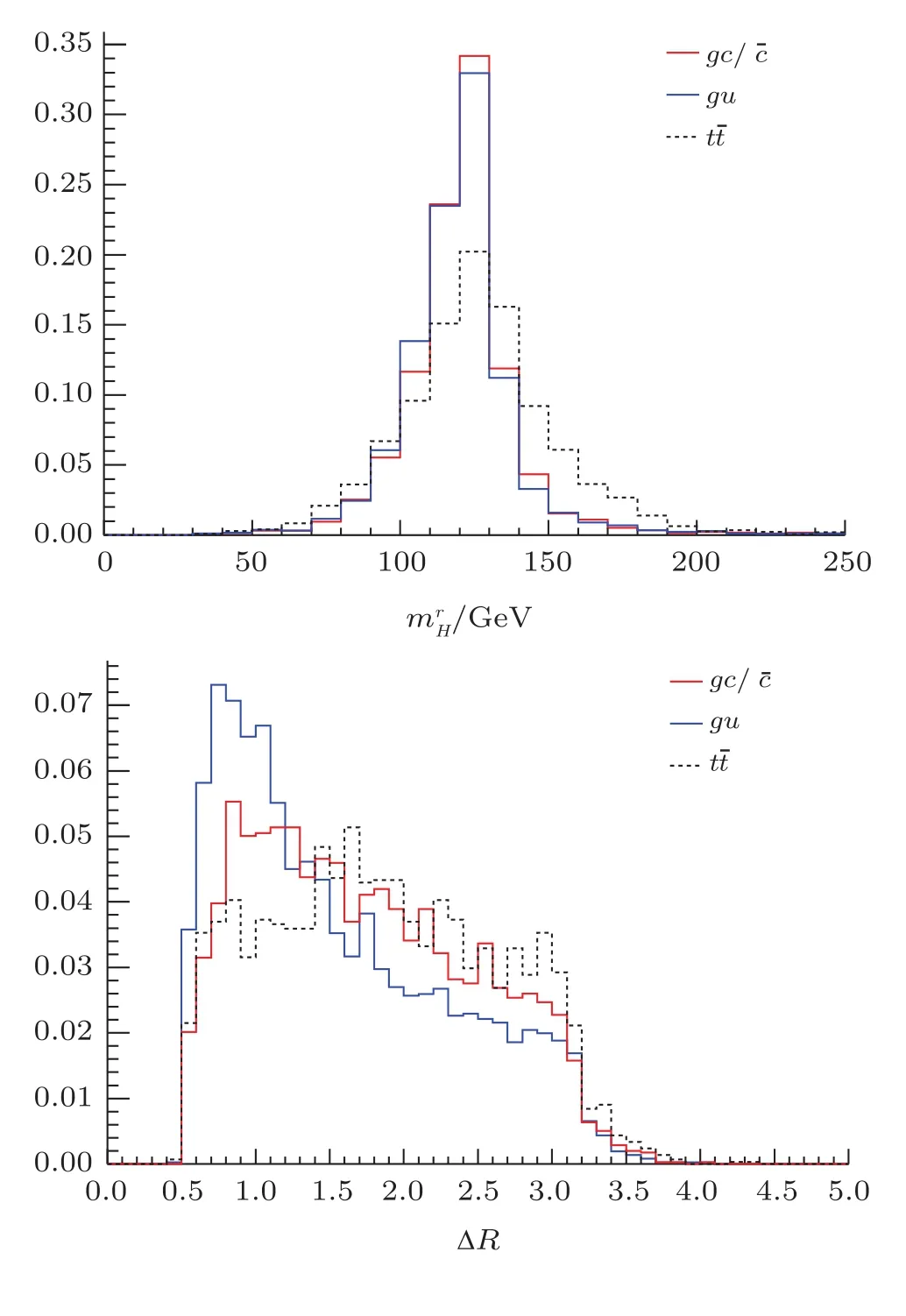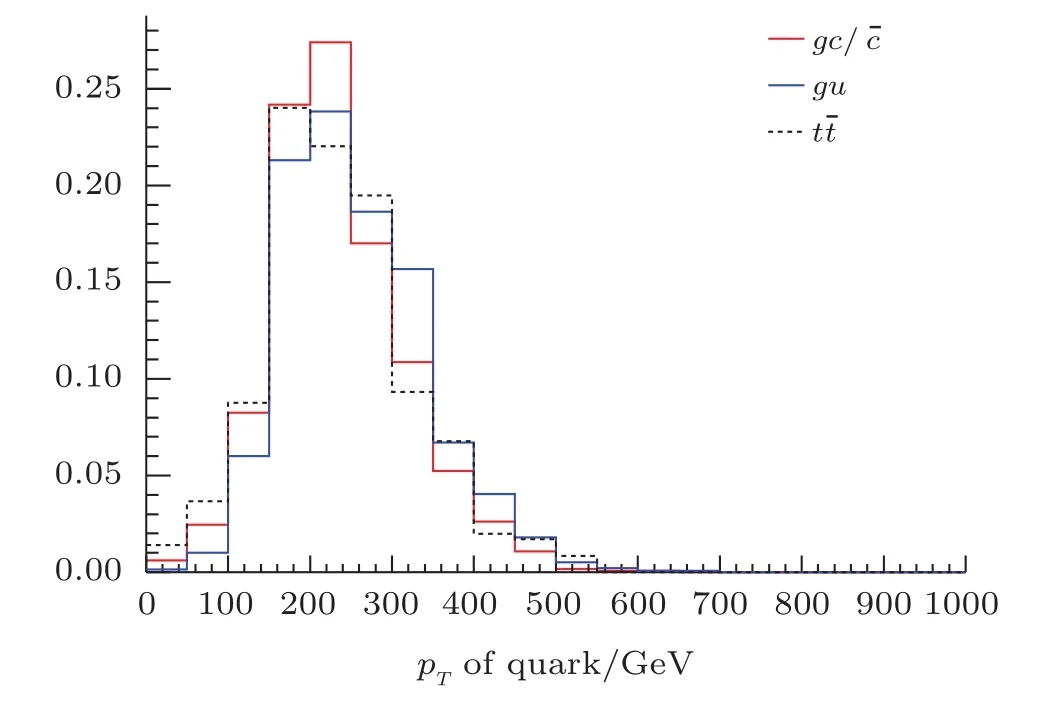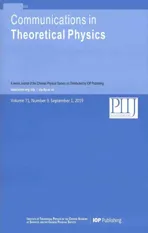Study of the FCNH Coupling with Boosted Higgs at LHC∗
2019-10-16ShouShanBao鲍守山
Shou-Shan Bao(鲍守山)
Institute of Frontier and Interdisciplinary Science,Key Laboratory of Particle Physics and Particle Irradiation,Shandong University,Qingdao 266237,China
(Received March 13,2019;revised manuscript received May 31,2019)
AbstractWe present a study about the flavor changing coupling of the top quark with the Higgs boson through the channel pp→Ht/¯t with H→ at LHC.The final states considered for the such process are l±+E/T+3b.We focus on the boosted region in the phase space of the Higgs boson.The backgrounds and events are simulated and analyzed.The sensitivities for the FCNH couplings are estimated.It is found that it is more sensitive for ytuthan ytqat LHC.The upper limits of the FCNH couplings can be set at LHC with 3000 fb−1integrated luminosity as|ytu|2=1.1×10−3 and|ytc|2=7.2×10−3at 95%C.L.
Key words:FCNH,LHC,boosted Higgs,new physics beyond SM
1 Introduction
The discovery of the Higgs boson at Large Hadron Collider(LHC)[1−2]is a great triumph of the Standard Model(SM).Following that,one can expect to test and search new physics through the precision measurement of the Higgs boson properties.In SM,the Higgs doublet is introduced to generate masses for the gauge bosons and the fermions.Most parameters in SM are related to Yukawa couplings.But the large difference between the Yukawa couplings has no answer in SM.On the other hand,the flavor changing neutral current couplings are absent at tree-level and suppressed at loop-level in SM.So that such processes are thought to be good clues to the new physics beyond SM,which have been widely studied through B-meson decays.
At present,the top quark is the heaviest elementary particle discovered,the mass of which is close to the electro-weak scale and could provide better clues to study the mechanism of electro-weak symmetry breaking and new physics beyond SM.The flavor changing neutral Higgs(FCNH)interactions of top quark are small and the branch ratios of FCNH decays are predicted as Br(t→ Hc)10−14and Br(t→ Hu)10−17in SM,[3−4]which are far below the sensitivity of LHC.Several extensions to the SM can enhance such interaction at tree level or loop level,e.g.two Higgs doublet model,[5−7]supersymmetry model,[8−10]and other new physics models.[11]One can expect that some new physics contributions would play significant roles in such FCNH interactions and such contribution could be discovered or constrained at LHC.The aim of this work is to study the sensitivity of LHC to the FCNH couplings of top quark.
In this work,we focus on the effective FCNH interaction between the Higgs boson and the top quark which can be expressed in general as[12−13]

where the ytqis the flavor changing coupling constant.Such anomalous couplings have been studied through t→ Hq rare decays,[13−15]the single top quark production with Higgs boson,[16−18]and same sign top quark production.[19]Through pp→with t→Hq using H →channel,ATLAS[20]and CMS[21−22]set upper limits at the 95%confidence level(C.L.)on the couplings as
ATLAS:Br(t→ Hc)<0.56%,Br(t→Hu)<0.61%,(2)
CMS:Br(t→ Hc)<0.47%,Br(t→Hu)<0.47%.(3)
In this work,the process pp → Ht/¯t with H →and t→ blν is considered.This process suffers large background frombbjj.Since the b−jets in background are from two different top quarks,they would be separated largely if the top quarks are boosted.At other side,the two nearby,separate resolved b-jets in signal events can be used to reconstruct the boosted Higgs boson efficiently.[23]
This work is organized as follows.In Sec.1,a brief introduction is given.In Sec.2,the cross-section of the signal process pp→tH is calculated.In Sec.3,the backgrounds and the significance are analyzed.Finally,a summary is given in Sec.4.
2 Cross-Section of Ht/at LHC
With the effective interactions in Eq.(1),the Feynman diagrams for the production of Higgs boson associated with a single top quark are shown in Fig.1.Due to the effect of Parton Distribution Functions(PDF),the crosssection of g→His overwhelmed by gu→Ht while the cross-section of g→His same to that of gc→Ht at LHC.One can choose the signal gu→Ht(bW+)with half backgrounds to study the effective interaction ytuwhile combine gc→Ht and g→Hto study the coupling ytc.In this sense,one can get a more stringent constrain on ytuthan that on ytcat LHC.
The numerical values of the inputs are listed in Table 1.The PDF set CT14NNLO[25]is used in this work.With these inputs,the leading order cross-sections are obtained and shown in Table 2,where the NLO QCD correction has been studied in Ref.[17].In the analysis,the events are generated at tree-level and the cross-sections are rescaled with the QCD k-factor as shown in Table 2.

Fig.1 The Feynman diagrams of Ht/ production at LHC,where q=u,c.

Table 1 The numerical values for the inputs taken from Particle Data Group.[24]
Table 2 Cross-section of the subprocess pp→Ht with ytq=1 at LHC with

Table 2 Cross-section of the subprocess pp→Ht with ytq=1 at LHC with
Process LO NLO(kQCD)g(c+¯c)47.3 pb1.40 gu 255.1 pb 1.22
If one takes ytc=which parametrization was used in Refs.[6–7],there would be

where l±denotesµ±and e±.
Top quark pair production in hadron collision can be calculated in perturbative QCD.However,higher order QCD corrections involving either virtual or real gluon emission lead to a sizable enhancement to the crosssection.Large logarithmically enhanced corrections due to soft-gluon radiation need to be resumed to improve the result.The pp →events are generated at LO and then rescaled to the NNLO+NNLL total cross-section as studied in Ref.[26].Other background like W+3j as studied in Refs.[17–18,27]can be suppressed strongly by the b-tag and large pTcuts.In this work,only thebackground is considered.All the events are simulated in MG5[28]+Pythia[29]+Delphes[30]with FastJet.[31]The Snowmass parameterizations[32−33]are applied in the simulations.
3 Cuts and Selections
The event selection requires one isolated high pTlepton(e orµ),missing energyin the W boson decay,and three tagged b-jets,one of which is from the top quark decay and the others are from the Higgs boson decay.Since then the basic acceptance cuts referred as Cut-I are applied as follows.
•Select the events with number of jets 3≤Nj≤4 and number of charged lepton Nl=1.
•Select the events 3 b-jets with PT>25 GeV and|η|<2.5.
• Charged lepton PT>25 GeV and|η|<2.5 while the missing ET>25 GeV.
• Apply the cuts∆Rαβ>0.4(α,β =jets and lepton).
The three b-jets in the selected events are from the Higgs boson decay and top quark decay.To specify them,the all possible invariant massare calculated.The two b-jets whose invariant mass are most close to the Higgs boson mass 125 GeV are chosen to con-struct the Higgs boson

The distributions of the signal and background on the ∆R and mrHof the two chosen b-jets are shown in Fig.2.The signal-background ratios S/B at different range of∆R are given in Table 3.According the distributions,the following cuts are introduced as Cut-II,


Fig.2 The normalized distributions of theand

Table 3 The Signal-background ratio in different range of∆R.
The charged lepton and left b-jet would be recognized as the final states from top quark decay.

The plot of the distribution(1/σ)/(dσ/dpT(top))is given in Fig.3.The signal-background ratios in different range of pT(top)are also got and listed in Table 4.To construct the Higgs boson,the two b-jets with small 0.4<∆R<1.4 were selected. That means the Higgs boson could be boosted with large PT.Since then the cut of top quark transverse momentum is applied as PT(top)>160 GeV,which is referred as Cut-III in this work.

Fig.3 Distribution of top quark pT.

Table 4 The Signal-background ratios in different range of top quark pT.

Table 5 The efficiency and cross-section for the signal and background with cuts.
The efficiencies of the above cuts are listed in Table 5.To estimate the LHC detect potential to the FCNH couplings,the significance of the signal events(NS)relative to a background events(NB)in terms of the Gaussian statistics is defined as

for which a signal at 95%(99%)C.L.corresponds to σS=2(3).With the definition and the cut efficiencies,the limits of the FCNH couplings at LHC with high luminosity=3000 fb−1could be obtained as

This limits of FCNH couplings can be translated to limits of the top quark rare decay brach ratios,

4 Conclusion
In this work,the anomaly Yukawa couplings ytqare studied through single top quark production associated with an SM Higgs boson.Such anomaly couplings can be introduced at tree-level or enhanced at loop-level in some new physics models.The boosted region is considered to reconstruct the Higgs boson and top quark.It is found that,the reconstruction is efficient in this region at LHC.One can expect such region more efficient at higher energy collider such as SPPC[34−35]in the future.And also the limits on the FCNH coupling of top quark could be set more stronger in 100 TeV proton-proton collision as studied in Ref.[36].With high luminosity,the LHC could constrain the ytqstrongly.Through H →channel,the limits could be set as Br(t→ Hc)≤ 4.1×10−3and Br(t→ Hu)≤ 6.2×10−4at 95%C.L.with 3000 fb−1at LHC.
Acknowledgments
The author would like to thank C.Kao and T.Han for helpful discussions.
杂志排行
Communications in Theoretical Physics的其它文章
- Thermodynamics Properties of Confined Particles on Noncommutative Plane
- New Optical Soliton Solutions of Nolinear Evolution Equation Describing Nonlinear Dispersion
- Numerical Analysis of Magnetohydrodynamic Navier’s Slip Visco Nano fl uid Flow Induced by Rotating Disk with Heat Source/Sink
- Coherence of Superposition States∗
- Exact Solution for Non-Markovian Master Equation Using Hyper-operator Approach
- Comparison Between χ2and Bayesian Statistics with Considering the Redshift Dependence of Stretch and Color from JLA Data
